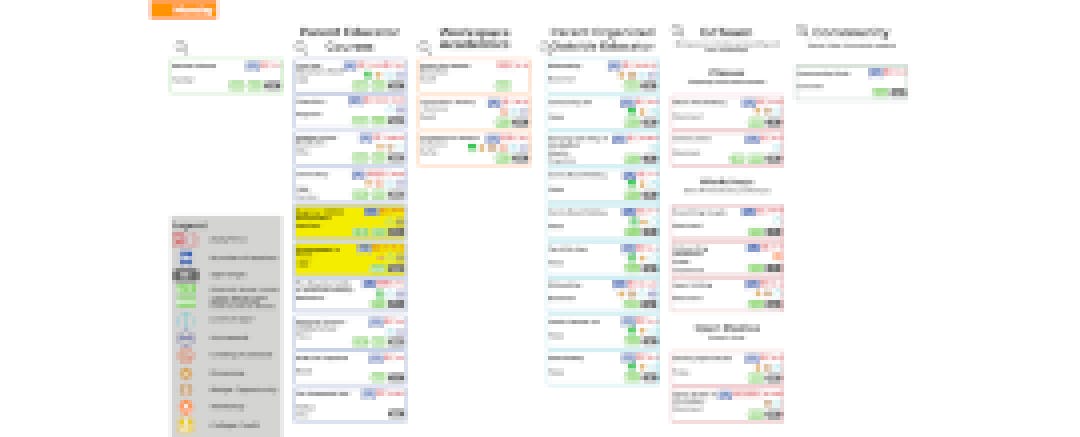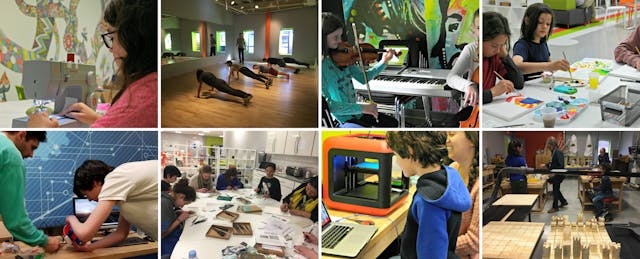BETHEL, Conn. — Henry was not thriving in his public elementary school. His grades were high, but apart from that, little else seemed to be going right for him.
“He wasn’t excelling, and everybody knew it,” his mother, Margaret Genden, explains. “And there were behavioral problems because of it. He wasn't acting out, but he didn't fit in.”
When Henry was in third and fourth grade, he would come home from school anxious, unhappy and complaining of migraines. His mother, growing increasingly concerned, felt it was time for a change.
First, Genden enrolled Henry in a private school, but the problems persisted. After having him go through a few education evaluations, Genden learned that her son had a processing gap, which specialists said he would eventually outgrow. In the interim, she decided to try homeschooling Henry, but she wanted him to be in an environment where he was stimulated and interacting with other kids. That’s how she found out about Workspace.
If traditional schools were too much and homeschooling alone was not enough, Workspace presented itself to the Gendens as the Goldilocks educational opportunity.
Nearly two years ago, in April 2017, Genden and her son approached a 32,000-square-foot building with a facade resembling a big red barn.
“We were 60 feet in the door and Henry turned around to me and said, ‘I'm coming here,’” Genden recalls. “And by the time we finished the tour, I was completely on board.”

Founded in January 2017 in the small town of Bethel, Conn., Workspace Education is distinct from perhaps any other place of learning. The expansive building contains rooms themed around seemingly every pastime and passion imaginable: Theater? Check. Recording studio? Check. Wood shop? Check. Makerspace? Community garden? Costume shop? Virtual reality suite? Fitness center? Science lab? Industrial kitchen? Space station? Robotics room? Check, check, check and more checks.
“It’s like homeschooling with jetpacks,” says Catherine Fraise, founder and executive director of Workspace. “I tried to think of every single way a human expresses themselves creatively, because I want every child to find themselves here.”
Fraise refers to Workspace as a “co-learning community.” Similar to how WeWork is equipped with all the bells and whistles of a modern office environment—save for the employees—Workspace provides all the tools necessary for learning—save for the students. First and foremost, it’s a place for families that homeschool their children to come and engage with others, supplement their learning and dive deeply into a wider range of topics than most parents are equipped to teach themselves.
“It’s about using the space as a tool for collaboration,” Fraise explains.
For example, a Workspace parent who is skilled in mathematics may volunteer to teach classes on algebra I and pre-calculus to Workspace kids. Or families who want their children to learn Spanish may pool their financial resources to hire a language specialist for a year.
Most courses are taught by parents, but at the request of the families, Fraise has hired a handful of certified educators, including Tom Curley, director of programming and master teacher at Workspace, to teach core subjects.
In a lot of ways, Workspace sounds like a school, says Curley, but that’s not quite right. Though it provides a space and resources where kids can learn, it does not issue transcripts or high school diplomas. The kids are legally considered homeschoolers, and their families are responsible for creating a curriculum and helping them fulfill graduation requirements.
“It’s a hybrid that I have not seen the likes of anywhere else,” Curley says. “We are unprecedented.”
Two years in, Workspace serves around 100 learners from 60 families—about half who came from homeschooling, and another half who came from traditional public or private schools. The latter tend to find their way to Workspace when their needs—be they cognitive, social, behavioral or academic—aren't being met by traditional schools. Students who come from other schools typically require a few months to get acclimated to Workspace, Fraise says, as they start off more timid and formal than their homeschooled peers.
The sweet spot, Fraise estimates, is 125 families. At that point, there will be enough variety and overlap in the families for Workspace to reach its full potential.
She explains: “If you want to start a band, you need to have enough people that make music, so until we get to that [optimal] number, you're not going to see the full vibrancy.”
Growing a Co-Learning Community
Fraise had been toying with the idea of starting Workspace for years, but it wasn’t until she saw a need in her own children that she became serious about it.
She had been a high school teacher in her home country of Australia before moving to the U.S. and starting a family. It was after the move that she learned about Maria Montessori, who designed an eponymous pedagogical approach that values collaboration and hands-on learning for children’s development. Fraise fell in love with the Montessori method and went back to school to pursue a master’s degree in it.
When her kids were of age, she put them in a Montessori school in the U.S., but due to their own sets of health and learning needs, which required additional attention, it wasn’t a great fit. When they were 4 and 9 years old, Fraise pulled them out and spent the next 10 years homeschooling them using a project-based approach that drew on her experience with the Montessori method.
But still, her children needed more than what she could offer them at home. They were two very different people with unique passions and strengths, and she wanted to give them an environment that would support and celebrate their individuality.
A few years ago, when she had the financial support she needed to start Workspace (her husband ran his own money management company and was able to provide capital for the facility), she got to work creating a “Google-like, incubative environment” that would help her kids and others find their niche.
However, Workspace does not just attract kids from the local area. In fact, few families who use the facility actually live in town. Parents and children drive in from all over the state—and some all the way from New York City, about 70 miles away—to get there. Fraise estimates that a quarter drive over an hour each way to Workspace.
But the existing space—formerly home to a bicycle company—was for sale in 2016 for about $1.7 million, nearly one-fifth the cost of building something from scratch, and as Fraise puts it, “people will drive to have this kind of experience.”
Courses at Workspace are often project-based, and the fundamental design is rife with what Fraise calls “authentic creative self-expression.”
“The most important part here is that we're creating children who are confident to manifest their own ideas,” she says. “So whatever idea they have, or anything that's in their head, I want them to be able to get it out into the world somehow.”
According to Fraise, the appropriate starting age at Workspace is around 9 or 10 years old, but she’s currently negotiating a purchase for two acres of nearby land, on which she plans to build another big red barn—this one for children ages 0 to 9.
Workspace is designed to be a hybrid between homeschool and private school. Compared to the average cost of private K-12 schools in Connecticut, which is nearly $25,000 per year, Fraise considers her model to be affordable and equitable. The basic membership plan for a family, which includes parents and one child, is $3,500 per year. Each additional child is $3,000.
Though Workspace tuition may be more affordable than most private school alternatives in the state, the expectation that parents be present with their children every day creates an obvious barrier to entry for many families.
On top of membership, many of the courses offered at Workspace come with an additional fee, usually to cover the price of materials. For instance, a marine science course taught on Mondays by one of the parents has free tuition but requires another $100 per “session” to cover materials, with an option of taking up to five sessions in a year (each session spans a seven- or eight-week period, and in this case marine science is offered 36 Mondays out of the year). That fee does not cover the price of field trips taken during the course.
Workspace has developed a course map that displays and breaks down each course offered throughout the year to help learners and families make sense of their options. No two children have the same schedule.

Using the course map, families can see that marine science is best suited for ages 12 and older, that it does not assign homework or record grades and that it takes place from 1-3 p.m. on Mondays.
Alternatively, families interested in Curley’s “Foundations of Western Civilization” course can see that the class is held twice a week and that each session comes with a $17 materials fee. It includes homework, grades and is marked as “rigorous.”
There is an expectation that parents will contribute to the Workspace community and teach a few classes themselves, Fraise says. It’s how they reciprocate all the time and attention other families invest in their own children.
For example, Henry’s mother Margaret Genden leads a multimedia art class and a geography class this year. Last year, she taught a writing and storytelling course for younger learners (she has a background in English literature). Fraise herself teaches courses on sewing and recycling, among others. The day EdSurge visited Workspace, she was talking about starting a Japanese-language class.
For now, Workspace does not provide enough course options for children to begin and end their learning in the facility. Families can come to Workspace for as few or as many hours a week as they choose, but most spend a day or two each week at home, during which time they’ll continue with other work, including online classes.
And if there’s something families want that isn’t currently offered at Workspace—say, an introductory journalism course—they can go to the “dream director” (yes, that’s her official title) and put in their request.
The sky-is-the-limit approach has worked well for many Workspace learners, including Henry, who is now 12 and is enrolled in more than a dozen different classes this year.
“He doesn’t want to be sick. He doesn’t want to be out. He wants to be here,” his mother says.
“The difference is absolutely life-altering,” she adds. “[Workspace] changed everything that we did, even as a family, in a positive way. All of a sudden, Henry was learning, he was thriving and [now] he’s doing things he would never have had the opportunity to do elsewhere.”


